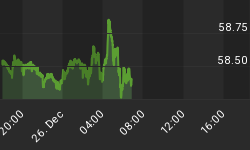Below is an excerpt from a commentary originally posted at www.speculative-investor.com on 6th August 2009.
There has been a lot of discussion in the mainstream financial press about how and when the Fed will withdraw the "monetary stimulus" it has provided over the past year. Also, Ben Bernanke has recently gone into considerable detail about the methods he will use, once the economy is on stronger footing, to gradually remove any excess money before an inflation problem arises. Unfortunately, these discussions and Bernanke's detailed plans betray a terrible misunderstanding about how money-supply changes affect the economy.
Most people who publicly comment on such matters appear to be labouring under the misapprehension that growth in the money supply has the potential to cause only one problem: a broad-based increase in prices. And, therefore, that injecting new money into the economy will not be a problem until/unless the general price level begins to rise at an undesirably fast pace. However, the reality is that growth in the money supply never has an evenly-distributed effect on the economy; rather, the money enters the economy at specific points and therefore affects different parts of the economy in different ways at different times. (As an aside, this is why monetary inflation is such a popular policy. If increasing the money supply caused all prices to immediately rise by a similar amount then nobody could benefit from the inflation, but the way inflation actually works is that the first receivers of the new money obtain a benefit, at the expense of everyone else, by getting to spend the money before it loses purchasing power. The first receivers of the new money tend to be the government, the banks, and the supporters and pet projects of politicians.)
In addition to understanding the non-uniform effects of newly created money, it is important to understand that creating money out of nothing TEMPORARILY makes it seem as if the economy-wide level of savings is higher than is actually the case. The result is lower interest rates and widespread investing in projects that would never see the light of day in the absence of the distorted monetary signals.
The non-uniform way in which new money enters the economy combined with the false impression created by lower interest rates leads to the large-scale transfer of resources and re-distribution of wealth. That is, injecting new money changes the STRUCTURE of the economy, not just the general price level. As a consequence of the monetary inflation, activities will occur that would not otherwise appear economically viable and these activities will collapse once the flow of new money is curtailed. Furthermore, a lot of the resources that get transferred to these inflation-sponsored activities will end up being lost to the economy and many of the businesses that spring up to support the projects that have been "stimulated" by the money creation will end up in bankruptcy. In other words, rapid monetary inflation leads to wastage on a grand scale.
The boom and bust of 2003-2008 is a classic example of what we are talking about. In response to the rapid monetary inflation and artificially low interest rates of 2001-2004, many projects were developed, businesses were started and investments were made that naturally collapsed during the years after the central bank tried to restrict the supplies of money and credit. Moreover, had the central bank not acted to curtail the boom then prices would have begun to accelerate upward throughout the economy and a different form of collapse would have eventually occurred.
The main point we are leading to is that the damage done by injecting a lot of new money into the economy cannot be undone by subsequently removing money from the economy. With regard to the current situation, the monetary profligacy of the past year has propped-up many businesses that should no longer exist and prompted investments that would not have been viable in the absence of the "stimulus". These businesses and investments will inevitably fail after pressure is applied to the monetary brake. And if the central bank refrains from tapping on the monetary brake then an inflation problem will emerge that even the Keynesians can recognise.
We aren't offering a free trial subscription at this time, but free samples of our work (excerpts from our regular commentaries) can be viewed at: http://www.speculative-investor.com/new/freesamples.html.















